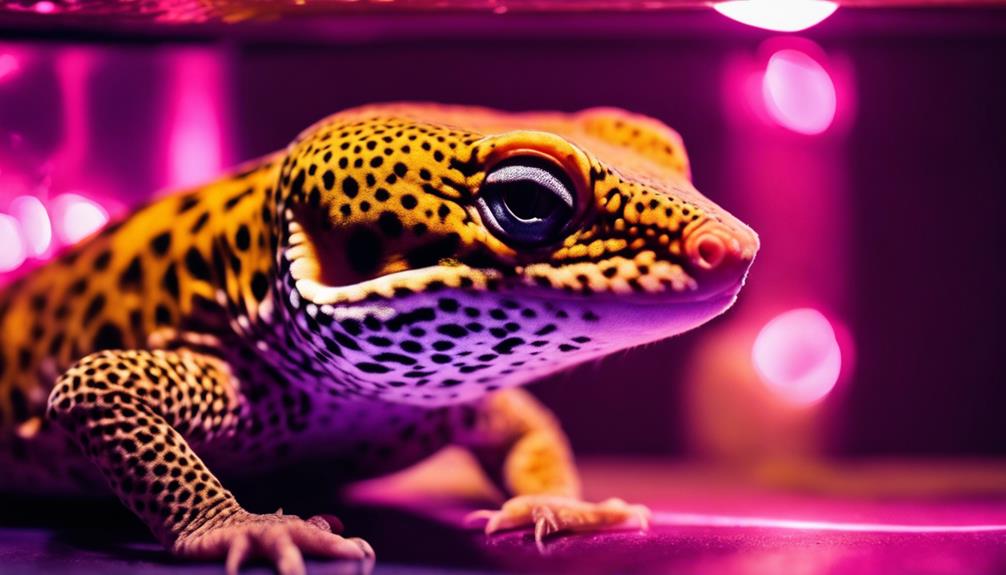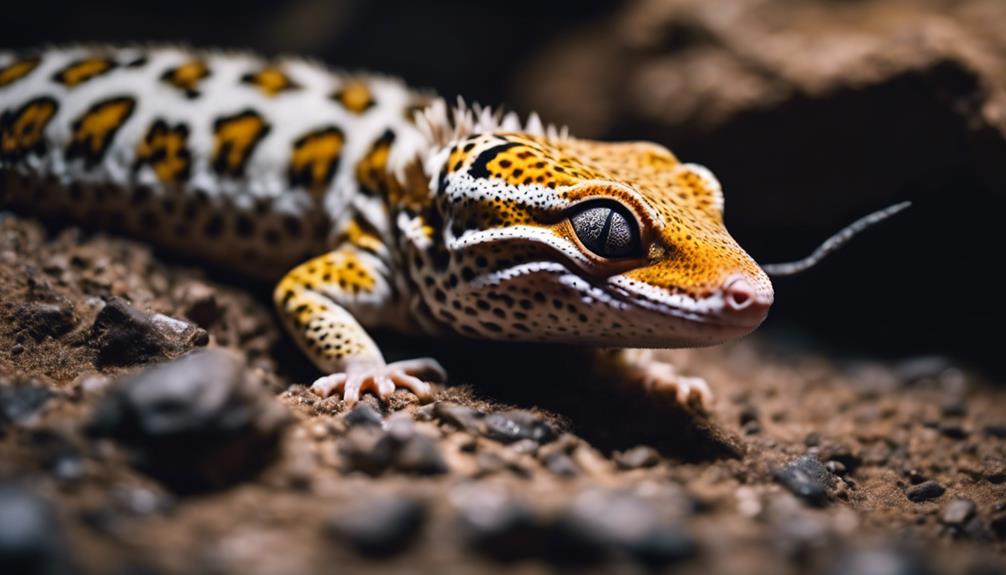Imagine your leopard gecko’s habitat as a carefully orchestrated symphony, where temperature plays the role of a conductor guiding the performance. Ensuring the right temperature for your gecko is like fine-tuning an instrument; each degree matters.
From creating a cozy basking spot to providing a cool retreat, every element contributes to your pet’s well-being. But what happens if the temperature is vital?
Stay tuned to discover the essential nuances of maintaining the perfect temperature balance for your leopard gecko and witness the harmony it brings to their world.
Key Takeaways
- Proper temperature gradient is crucial for health and digestion.
- Imbalanced temperatures can lead to metabolic bone disease.
- Select appropriate heat sources for zones ranging from 88-92°F.
- Regularly monitor and adjust temperature levels for effective thermoregulation.
Importance of Proper Temperature for Leopard Geckos
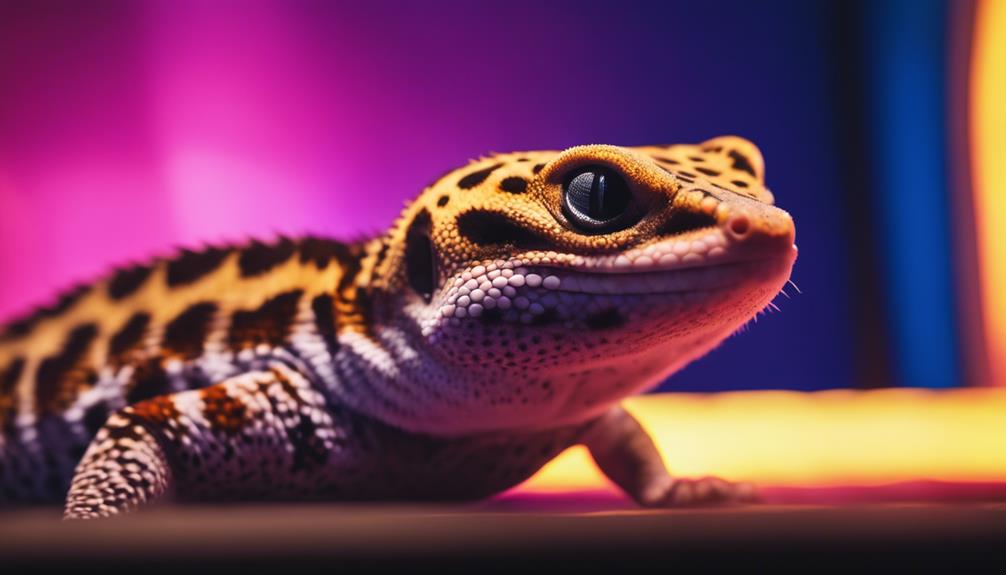
Maintaining a proper temperature gradient in the leopard gecko enclosure is essential for their health and well-being.
Imbalanced temperatures can lead to digestion issues and impact their thermoregulation abilities.
Ensuring the correct temperature zones through heat mats or basking lights is vital to prevent health risks associated with incorrect temperatures.
Temperature Gradient Importance
Proper temperature gradient is essential for leopard geckos to effectively regulate their body temperature. This gradient should consist of a warm basking area ranging from 90-93°F, important for digestion, and cooler areas where geckos can seek refuge. Avoid temperatures exceeding 33°C, as this can deter geckos from basking, impacting their natural behavior.
Offering a wide thermogradient in the enclosure allows geckos to select the temperature that best suits their requirements for thermoregulation. Monitoring gecko behavior in response to temperature fluctuations is key; it provides insights for adjustments to maintain an ideal gradient.
Make sure the setup includes heat sources like mats, tape, or basking lights to establish and uphold the necessary temperature differentials.
Health Risks of Imbalanced Temperatures
Imbalanced temperatures pose significant health risks to leopard geckos, impacting various metabolic functions essential for their well-being. When temperatures aren’t within the appropriate range, leopard geckos are at risk of developing metabolic bone disease, which weakens their bones and can lead to deformities.
Incorrect temperatures can also disrupt digestion processes, hindering nutrient absorption important for the geckos’ overall health. Inadequate temperatures may compromise the geckos’ immune system, making them more susceptible to illnesses and infections.
Additionally, extreme temperature variations can cause stress and discomfort, negatively affecting the geckos’ well-being. Ensuring a proper temperature gradient in the enclosure is important to prevent these health risks and promote the longevity of your leopard gecko.
Creating a Temperature Gradient in the Enclosure
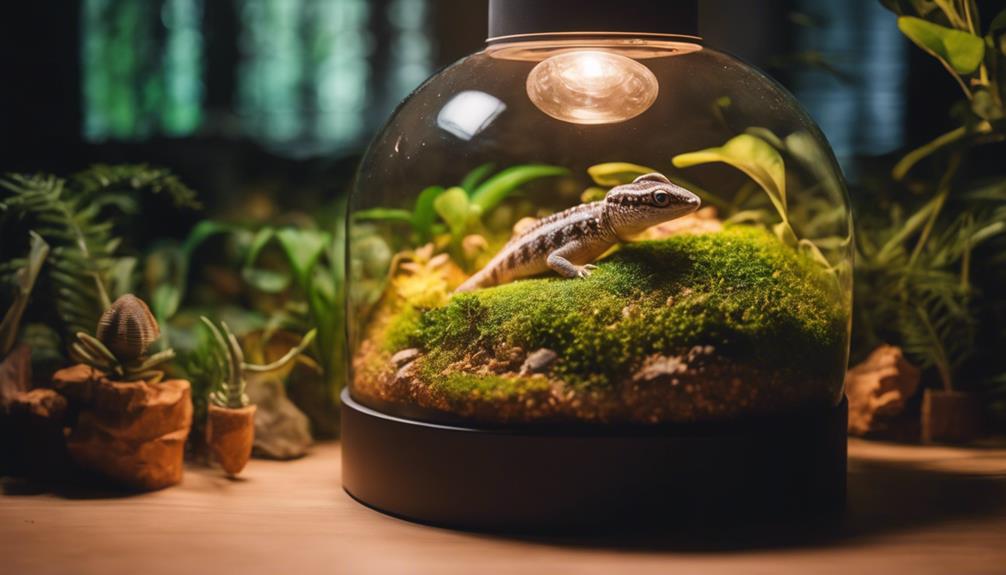
To create a temperature gradient in the enclosure, make sure you select appropriate heat sources like heat mats, heat tape, or basking lights. Place these heat sources strategically to establish temperature zones ranging from 88-92°F (31-33°C) on the warm side to 70-75°F (21-24°C) on the cool side.
Regularly monitor the temperature levels to guarantee effective thermoregulation for your leopard gecko.
Heat Source Selection
When creating a temperature gradient in a leopard gecko enclosure, selecting a suitable heat source is crucial to provide the necessary warmth for thermoregulation. To achieve this, consider the following options:
- Heat Mat: Ideal for offering belly heat and maintaining ambient temperature in the terrarium.
- Ceramic Heat Emitter: Emits infrared heat without light, suitable for nighttime temperature maintenance.
- Heat Lamp: Provides a basking spot for geckos to warm up and regulate body temperature effectively.
Make sure the selected heat source only covers part of the enclosure, allowing the geckos to move to cooler areas as needed. This setup will facilitate the creation of a temperature gradient essential for your leopard gecko’s well-being.
Temperature Zone Placement
Selecting appropriate heat sources plays a key role in establishing the necessary temperature gradient within a leopard gecko enclosure for prime thermoregulation. Place the basking area at the warmest end, reaching temperatures of 90-93°F (32-34°C).
Create a gradient with the middle section around 85°F (29°C) and the cooler end at 75-80°F (24-27°C). This setup allows geckos to regulate their body temperature effectively by moving between these zones. Adjust the placement of heating elements strategically to provide a comfortable and diverse thermal environment.
Offering a wide temperature range enables geckos to self-regulate and select their preferred heat level. Observing gecko behavior within these temperature zones will help fine-tune the setup for prime thermoregulation.
Monitoring Temperature Levels
Creating a temperature gradient in the enclosure for leopard geckos involves strategically monitoring and adjusting heat sources to establish distinct warm and cool zones essential for their thermoregulation. To guarantee ideal conditions for your leopard gecko, consider the following:
- Basking Surface Temperature: Maintain a basking surface temperature ranging between 90-93°F to support digestion and metabolism.
- Nighttime Temperatures: Allow nighttime temperatures to drop to around 60°F, enabling geckos to cool down and regulate their body temperature effectively.
- Warm Hides and Cool Ends: Provide warm hides with temperatures around 85-90°F and cool ends at 70-75°F to create a comfortable environment for gecko thermoregulation.
Monitoring temperature levels on both ends of the enclosure is essential for the overall health and well-being of your leopard gecko.
Equipment for Maintaining Ideal Temperatures
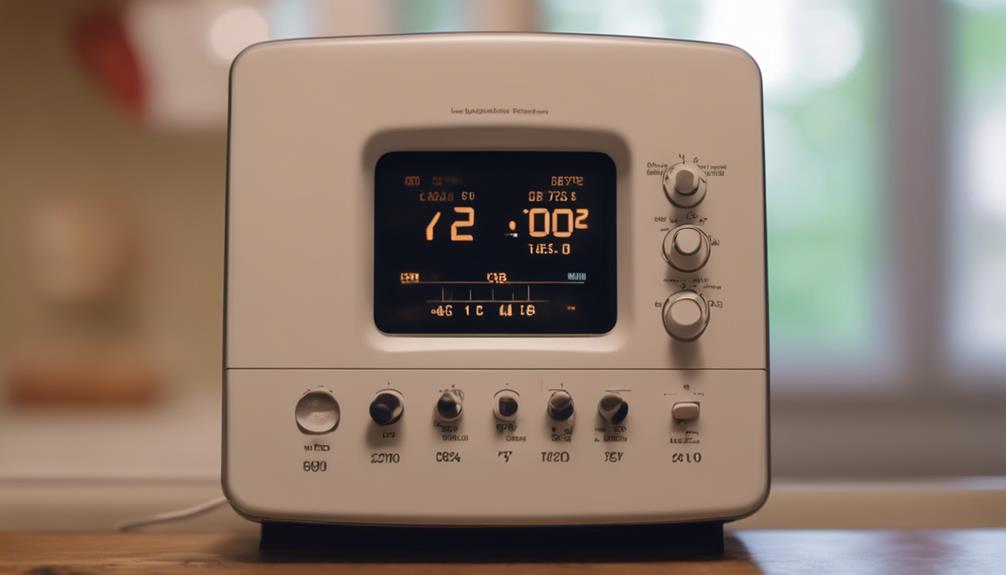
To maintain ideal temperatures for your leopard gecko, make sure you have the necessary equipment in place. This includes heat sources like heat mats, heat tape, or basking lights for creating the required temperature gradient.
Utilize tools such as digital thermometers with probes, ceramic heat emitters, proportional thermostats, and temperature guns for accurate monitoring and regulation within the enclosure.
Heat Sources Overview
Heat sources important for maintaining the ideal temperatures in a leopard gecko enclosure include heat mats, heat tape, basking lights, ceramic heat emitters, and deep heat projectors. These devices play a critical role in creating specific temperature zones within the gecko’s habitat.
- Heat mats and heat tape: Positioned underneath the tank, these tools provide a warm surface for the gecko to rest on, aiding in overall thermoregulation.
- Basking lights: By simulating the sun’s warmth, these lights help maintain the gecko’s basking area at the appropriate temperature, crucial for digestion and overall well-being.
- Ceramic heat emitters and deep heat projectors: These equipment are effective at creating localized heat sources that mimic natural basking spots, assisting in maintaining the necessary temperature gradient for your leopard gecko’s health.
Temperature Gradient Setup
To establish a perfect temperature gradient within your leopard gecko enclosure, strategically position a combination of heat sources such as heat mats, ceramic heat emitters, or basking lights on one side of the tank. This setup creates a warm area for basking and digestion, necessary for your gecko’s well-being.
Monitor the temperatures with a digital thermometer to guarantee the basking spot reaches 90-93°F (32-34°C) while the cooler side stays around 75-85°F (24-29°C). Adjust the wattage or distance of the heat sources to maintain the desired temperature range throughout the day and night.
Providing hides on both the warm and cool sides helps leopard geckos regulate their body temperature effectively, making sure they can thermoregulate as needed.
Monitoring Temperature Levels
For accurate monitoring of temperature levels in your leopard gecko enclosure, utilize a digital thermometer equipped with probes to guarantee precise readings in various zones. To maintain ideal temperatures effectively, consider the following equipment:
- Thermostat: Use a thermostat to regulate heating devices and make sure stable temperatures within the recommended range.
- Infrared Temperature Gun: Spot-check specific areas with an infrared temperature gun to ensure accuracy and the gecko’s comfort.
- Thermometers Placement: Place thermometers at both warm and cool ends of the tank to establish a proper gradient for the gecko to thermoregulate efficiently.
Monitoring and Adjusting Temperature Levels

Utilize a digital thermometer to accurately monitor the temperature levels within the leopard gecko enclosure. Regularly check the basking surface temperature to ensure it falls within the best range of 90-93°F (32-34°C). If the temperature deviates from the recommended range, adjust the positioning of heating elements or their wattage accordingly. It is important to maintain a clear temperature gradient in the enclosure to facilitate effective thermoregulation for the gecko’s well-being. Observing the gecko’s behavior regularly can provide insights into its comfort with the temperature levels, allowing you to make necessary adjustments promptly.
| Temperature Zone | Temperature Range | Purpose |
|---|---|---|
| Warm Side | 88-92°F (31-33°C) | Provides a warm area for digestion and thermoregulation |
| Cool Side | 70-75°F (21-24°C) | Offers a cooler retreat for the gecko |
| Basking Area | 90-93°F (32-34°C) | Specific spot for heat absorption and basking |
Preventing Health Issues With Correct Temperatures
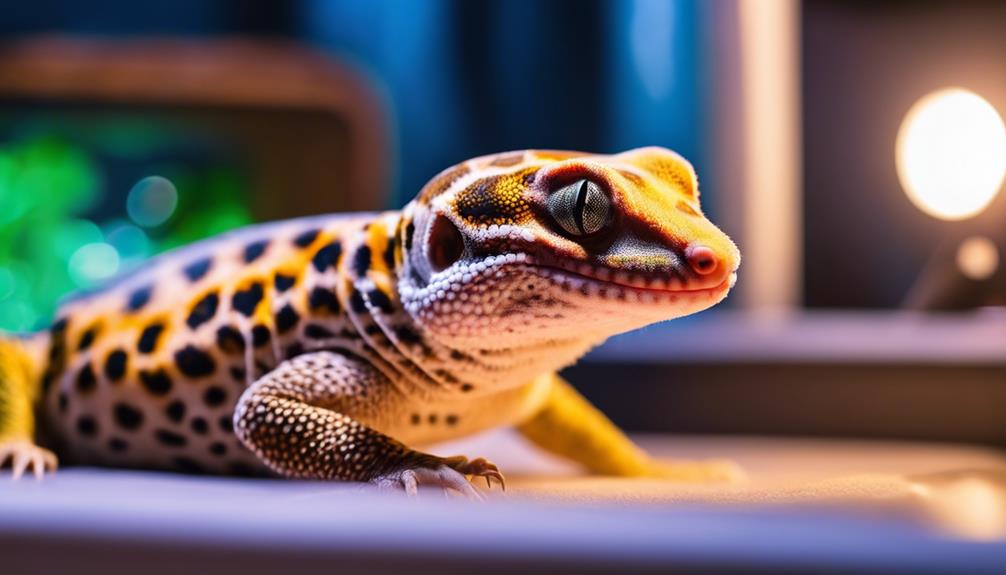
When maintaining correct temperatures in a leopard gecko enclosure, ensuring a basking area temperature of 90-95°F is crucial for aiding in digestion and overall well-being.
To prevent health issues with correct temperatures, consider the following:
- Proper Digestion: Adequate temperatures, especially in the basking area, help leopard geckos digest food efficiently and prevent digestive problems.
- Warm Side and Cool Side: Maintaining a temperature gradient between 88-92°F on the warm side and 70-75°F on the cool side allows geckos to regulate their body temperature effectively, reducing stress and health issues.
- Humidity Levels: Besides temperature, monitoring humidity levels is vital. Leopard geckos require a humidity level of around 30-40% to aid in shedding and prevent respiratory issues.
Maintaining correct temperatures, including a warm basking area, a gradient from warm to cool sides, and appropriate humidity levels, is crucial for preventing health issues in leopard geckos.
Proper temperature regulation ensures optimal digestion, reduces stress, and promotes overall well-being for these fascinating reptiles. Regular monitoring and adjustments are key to creating a healthy environment for your leopard gecko.
Frequently Asked Questions
What Is the Ideal Temperature for Leopard Geckos?
You need to make sure the temperature in your leopard gecko enclosure is between 88-92°F on the warm side and 70-75°F on the cool side. Create a gradient with heat mats or lights for effective thermoregulation. Regular monitoring is important.
Is 90 Degrees Too Hot for a Leopard Gecko?
If your leopard gecko is exposed to 90 degrees Fahrenheit, monitor closely for signs of discomfort. Guarantee a cool area for relief. Behavior observation is key; adjust if needed for their well-being. Follow temperature guidelines for a healthy gecko.
Is 70 Degrees Too Cold for a Leopard Gecko?
Yes, 70 degrees is too cold for a leopard gecko. Perfect temperatures range from 88-92°F on the warm side and 70-75°F on the cool side. Guarantee correct temperature zones with heat mats or basking lights for proper thermoregulation. Regular monitoring is essential.
Do Leopard Geckos Need Heating at Night?
At night, leopard geckos can handle a slight temperature drop, but providing some heat, like a ceramic heat emitter, guarantees their comfort. While not mandatory, it helps maintain their well-being, akin to enjoying a cozy blanket.
Conclusion
Just as a perfectly tuned instrument produces beautiful music, maintaining the ideal temperature for your leopard gecko is vital for their health and well-being.
By creating a temperature gradient in their enclosure, providing the right equipment, and monitoring levels regularly, you can guarantee your leopard gecko thrives in their habitat.
Remember, a harmonious thermal environment is the key to a healthy and happy leopard gecko, just like the perfect melody is essential for a mesmerizing symphony.
